Updated 6/18/2024
Why We Either Love Or Hate Cilantro
Cilantro is one of those herbs that can elicit memories of mouth-watering foodie forays to Mexico, China, and India, or… maybe not! People who know it either love it or hate it. Count me among those in the latter category. But, as a grower, I included it in my farmers’ market inventory, displaying it downwind from where I stood.
Those who dislike cilantro have a spot in their genotype resulting in taste and olfactory receptors that can detect aldehyde compounds. This substance reminds us of soap or something metallic. About 15% to 20% are not keen to keep it in the kitchen, although in those countries where it is a dietary staple, a greater percentage of the population like it. Closer to 25% of my customers did not use cilantro.
Cilantro originated in Iran, and spread to southern Europe, northern Africa, and southeast Asia. It has been cultivated for several thousand years. In fact, the oldest remains of coriander were discovered in pottery found in a dry Israeli cave. They were dated to approximately 8,000 years ago!
This article describes some of the problems gardeners face when growing this plant and offers some solutions.
The Nature of Cilantro
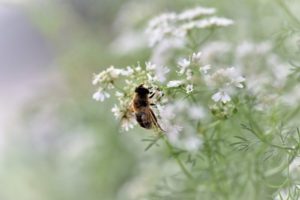
Cilantro flowers.
The difference between cilantro and coriander (Coriandrum sativum) is based simply on which part of the plant you’re referring to. Cilantro refers to the leaves and coriander refers to the seed.
Cilantro is a short-lived annual that prefers cool weather. All parts are edible, including the roots, although leaves and seeds are consumed most often. Other parts might be bitter.
As a member of the Apiaceae family, its flowers are umbel-shaped, as indicated in the former name for the family, Umbelliferae. This family of plants also includes parsley, dill, chervil, celery, fennel, and carrot—all characterized by their umbrella-shaped flowers. The current family name is a clue that bees (such as the honey bee, Apis mellifera) are attracted to the flowers.
Cilantro Substitutes
Another plant with similar flavor grows better in the summer than most varieties of cilantro. Mexican coriander (Eryngium foetidum), also in the family Apiaceae, from Mexico to South America and the Caribbean, is popular in the cuisine of the area. Slow to grow from seed, culantro (with a “u”) develops leaves with raspy edges, so use the younger foliage in cooking.
Vietnamese coriander, Persicaria odorata, a perennial native to southeast Asia, also has cilantro-like flavor. It’s in the Polygonaceae family and is related to the smartweeds and knotweeds.
Papalo (Porophyllum ruderale or P. tagetoides, in the Asteraceae family) is a herbaceous annual found in Central and South America. It has cilantro flavor, apparently with mint and arugula mixed in.
Although these herbs can substitute for cilantro, this article describes the plant we’re more familiar with—Coriandrum sativum.
Consider Climate
In the moderate climates of the southern U.S., cilantro planted in the autumn grows beautifully, but slows down as cold weather approaches. It often survives winter conditions with a little protection or with none at all. From the end of winter into spring, it resumes growth.
Before long, warm temperatures signal the plant to flower. When the new leaves become small and finely dissected, flowering soon follows. Pull the whole plant and use the harvested leaves. Time to start a new crop! It is best used fresh; most flavor is lost when dried.
Successive crops of cilantro grow from spring through fall in the northern half of the country. A prolonged summertime heat wave, though, even far into the north, is the beginning of the end for this crop of cilantro. Try shading young plants during hot weather, and water with cold water to prolong the harvest.
Winter Protection
Cilantro is not likely to survive severely cold winters without the protection of a cold frame, a greenhouse, or a sunroom. Don’t coddle it with indoor temperatures that are comfortable for you. Grow it very cool, even cold (40’s to low 60’s F), for longevity and the best quality.
An unheated greenhouse offers adequate conditions for continued growth through the winter in the southern half of the country. Farther north, cilantro will grow in such a structure with minimal heating. Remember to open vents to prevent overheating in the daytime, and close them in mid to late afternoon.
Coriander
If you’re growing cilantro for the seeds (coriander), let the plant mature naturally. Small white flower clusters will develop fruits, each of which contains 2 seeds. The round seedpods are fairly large and can be harvested when they are light brown and dry, but don’t wait until they start rolling away! Consider loosely wrapping the flower clusters with a fine mesh bag in order to catch the seeds.
Another way to harvest the seeds is to pull the plant and hang it upside down, in a mesh bag or a paper bag that permits air flow. Just make sure there are seeds already developing before you uproot the plant.
Or, let Mother Nature do her thing. Let the plant stay in the garden, go to flower, and set seed. The varieties of cilantro I’ve grown are open pollinated and not hybrids, so the next generation will look and taste like the parent generation. Ripened seeds will fall to the ground and germinate. But you might see young seedlings growing a few feet away, or at the end of the sidewalk. Maybe the critters that reside in your garden will be the only ones to reap this harvest.
What Cilantro Likes
When growing cilantro, remember these 5 things: cool, young, fertile, moist, and fast. I’ll call them “Cilantro’s 5 Needs”. Customers often complained that the transplants they’d just bought from the garden center immediately went to seed. The following tips will help you grow a great crop of cilantro.
Keep a supply of seeds on hand, in case nurseries in your area don’t have the plants. Cilantro seeds germinate and grow rapidly. Starting cilantro from seed is one of the easiest projects for beginning gardeners. Seeds remain viable for a few years if they’re kept cool and dry.
1. Cool
Ask for cilantro in February or March, or whenever the “shoulder season” occurs where you live. Although that’s weeks before the last spring frost, that’s precisely what cilantro likes.
Make sure the plants are properly hardened off. That’s a process that gradually introduces cooler, sunnier, and breezier conditions to a greenhouse-grown plant. Any plant that is coddled in the warm, almost still environment inside a greenhouse is very likely to suffer stress or even death when suddenly exposed to the rigors of the outdoors.
During the cooler months of the year and during the transitional shoulder seasons, grow cilantro in full sun. At higher temperatures, provide direct sun in the morning hours, and light shade the rest of the day. You might have better results growing cilantro in the summer if it is planted in dappled sun or light afternoon shade cast by a tomato plant.
Because garden soil is cooler than soil in a pot, summer-grown cilantro will last longer if it’s planted in the ground. A thin layer of mulch will keep the soil a bit cooler.
Pot Color
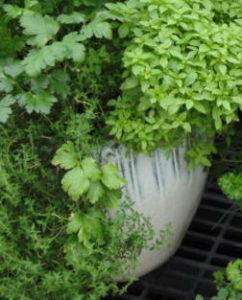 If your only option is growing cilantro in a pot, choose a light-colored pot during the warm months and a dark pot in the cooler months. Why? Because the color of the pot reflects or absorbs energy from the sun.
If your only option is growing cilantro in a pot, choose a light-colored pot during the warm months and a dark pot in the cooler months. Why? Because the color of the pot reflects or absorbs energy from the sun.
Summer sun beating down on a lovely cobalt blue ceramic pot can heat the soil to over 100°F. Conversely, a dark pot absorbs the sun’s energy in winter, and keeps the soil unfrozen a while longer.
If you want to include cilantro in a combination planter, plant the cilantro on the east or north side (in the northern hemisphere) of the pot. The soil there will be cooler than that on the south or west side.
2. Young
When purchasing plants from a grower, look for the youngest ones you can find. However, they shouldn’t be so young that the root system is too fragile to survive the transplant. Unless you need fresh cilantro now, avoid large plants in small pots.
If the plants are potbound, where roots tightly fill the pot, they are stressed. They should not stay in their little pots so long that the cramped quarters check their growth. If they have not been fertilized, or if they are showing signs that even a young plant’s leaves are getting finer in texture, they are stressed. And stressed cilantro plants bolt, or flower prematurely.
I’ve seen cilantro with one seed per pot and I’ve seen it sown with 50 seeds in a pot. You want to find the happy medium, the right number of seeds to give lots of leaves to pick, but not so many that they intensely compete with each other. When I grow cilantro for sale, I sow 3 to 5 seeds in a pot.
Since cilantro is a short-lived plant to begin with, its days are numbered with any of those warning signs: tight pot, too many seeds, finely dissected leaves, poor color. And if they’re already in flower, plant them, pick what you can, and let the bees collect nectar and pollen…for a little while. You can try cutting them back hard. If weather is favorable, you might get some regrowth out of them, but not usually.
3. Fertile

Organic fertilizers, including worm castings, bat guano, blood meal.
Dark green leafy herbs, such as parsley, basil, arugula, mint, and cilantro, need rich, fertile soil. Nitrogen, one of the primary macronutrients, is needed on a regular basis and in larger amounts than other nutrients.
Nitrogen is highly mobile, so it is easily washed through the soil by rain or irrigation. Potted leafy herbs should be fertilized every 1½ to 3 weeks, depending on soil quality, frequency of irrigation, temperature, and pot size.
Without enough nitrogen, plants lose their rich green color and become pale. New growth slows down, and older leaves turn yellow and eventually die. More importantly, poorly colored leaves taste bitter or, at least, off-flavor.
Many plant experts recommend not fertilizing herbs, but I disagree. And, no, fertilizer doesn’t make cilantro toxic! Fertilizers break down into simpler molecules, and the plant recombines these molecules into compounds needed to carry out cellular processes.
N-P-K
For cilantro, use fertilizer that has a higher first number on the package. Examples: 10-6-4, 24-8-16, and fish emulsion’s 5-1-1. Those 3 numbers on the product label refer to the percentage content of Nitrogen, Phosphorus (phosphate), and Potassium (potash) in the formula. They always appear in that order on any label: N-P-K.
Nitrogen is essential for building chlorophyll, the green pigment in foliage and stems. Phosphorus stimulates flower and fruit production, and root development. Potassium affects cell wall strength and hardiness. This is a simplified depiction of the roles these 3 major nutrients play; there are many other ways they contribute to plant growth and function.
4. Moist
Keep soil evenly moist—not too dry, which causes wilt, and not too wet, which rots the roots. Once root rot has claimed the root system, it will not recover. Make sure the soil drains well, and don’t let the plant sit in a saucer of water. A well-established potted plant likes a thorough watering—that is, until water begins to exit the drainage hole.
Sometimes water rushes out the drainage hole immediately after application. This occurs when the soil has dried too much, causing the root ball to shrink from the inside of the pot. The next time the plant is watered, the water will find the path of least resistance, which is the air gap between the inside of the pot and the root ball. Most of the root ball will miss the opportunity to absorb water. Fill the gap with potting soil and use a wooden dowel or chop stick to firm the soil, filling the space. This will slow down percolation, allowing the entire root system to pick up moisture.
Potting soils with a large percentage of coarse material, such as perlite and pine fines (or “wood products”), drain and dry quickly. Products with finer particles, such as peat moss, compost, and loam, tend to hold water better.
Garden soil well-enriched with compost, aged manure, or planting mix encourages deep rooting. Lower levels of soil, 8-12″ down, are cooler and have more moisture, contributing to a longer life for this herb. Cilantro is less susceptible to root damage in freezing weather when grown in the ground.
Cilantro doesn’t mind cool water from the tap or even refrigerated water, but never use warm or hot water. Check the temperature of water coming from a hose that has been sitting in the sun; it might be too hot for any plant!
5. Fast
An herb that completes its life cycle in a short period of time, like cilantro, can’t be forced to live as long as other plants do. It’s not in its nature! You can have cilantro almost year-round, though, if you start seeds every few weeks or purchase new transplants, if they’re available.
Weather permitting, sow a few seeds 4″ apart in a row, about 1/2″ deep. If the soil isn’t too cold, seeds should germinate in a week to 10 days. As the seedlings grow, thin to 1 or 2 plants per 4″ of row; thinnings can go right to the kitchen.
Another option is to experiment, sowing a few seeds in each of several spots around the garden. You’ll soon notice where they grow best in any particular season.
In soils with high clay content, loosen the bed to a depth of 12-14″, incorporating (not layering) pine fines or grit to increase drainage. Amending the top 6-8″ of the garden bed with lots of organic matter encourages roots to grow quickly. Apply fertilizer every few weeks to encourage leaf production.
You can begin harvesting some of the leaves soon after transplanting, or a month or so after seeding. Pick mature outer leaves first but allow the young leaves in the center of the rosette to continue growing.
Headings
Page 1: Why We Either Love Or Hate Cilantro, The Nature of Cilantro, Cilantro Substitutes, Consider Climate, Winter Protection, Coriander, and What Cilantro Likes (Cool, Young, Fertile, N-P-K, Moist, Fast)
Page 2: What Is Eating My Cilantro? (Rabbits and Deer, The Black Swallowtail Butterfly, Safe Haven, Raising Caterpillars, At The Olney Farmers’ and Artists’ Market), More Insects and Diseases (Insects and Nematodes, Diseases), and The Best Variety I’ve Grown
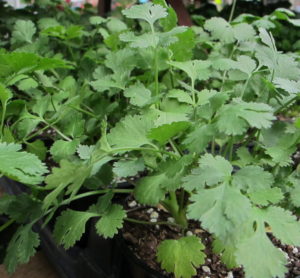
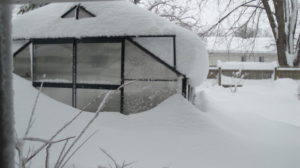
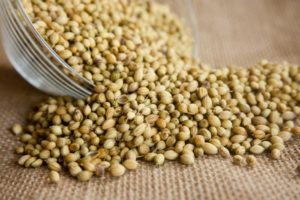
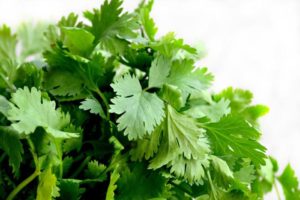
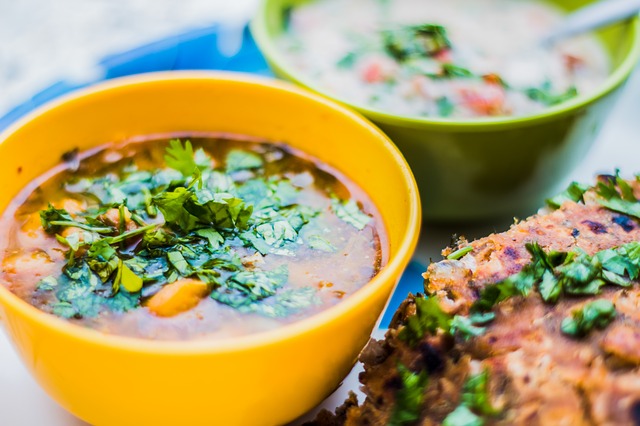
You’re welcome. Yes, cilantro can be tricky. Timing counts!
Thank you so much for sharing this post. I have some cilantro that
bolted rather quickly (I didn’t even get a chance to use it).
LOL! Now I see the seeds and was wondering when to collect them.
Now I know. Thank you.